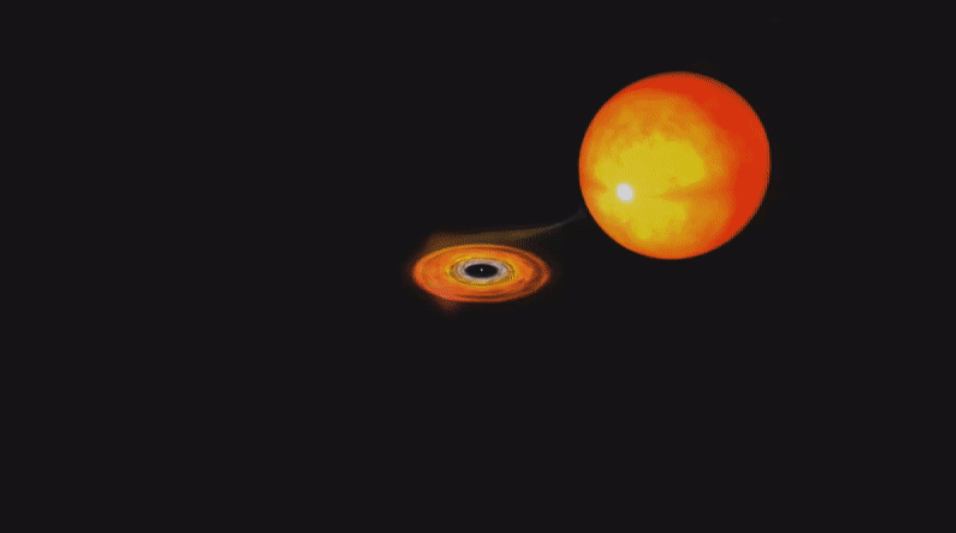News
Millisecond Pulsars from Accretion Induced Collapse naturally explain the Galactic Center Gamma-ray Excess

"Millisecond Pulsars from Accretion Induced Collapse naturally explain the Galactic Center Gamma-ray Excess", reports a team of astrophysicists including GRAPPA fellow Oscar Macias. The paper published in Nature Astronomy can be found here.
Gamma-ray data from the Fermi-Large Area Telescope reveal an unexplained, apparently diffuse, signal from the center of the Milky Way. The origin of this “Galactic Center Excess” has been debated with proposed sources prominently including self-annihilating dark matter. However, recent studies have put forward evidence supporting the claim that this excess could have an astrophysical source. It was pointed out that old and fast spinning neutron stars called millisecond pulsars could also be responsible for the signal. If the Millisecond Pulsar interpretation holds, the Galactic Center Excess would be evidence of a new population of astrophysical sources in the center of the Galaxy which would help shed light on the star formation history of the Milky Way.
Hitherto, much of the discussion regarding the plausibility of the millisecond pulsar interpretation has been based on the ‘recycling’ scenario where an old neutron star, formed originally via a core-collapse supernova, accretes material from a binary companion, in an X-ray binary phase, and is spun up to millisecond periods. In our study we focus on a millisecond pulsar formation channel which produces more than half of all millisecond pulsars: accretion induced collapse. The birthrate of accretion induced collapse pulsars has been previously shown to be comparable or even larger than the traditional core-collapse supernovae by various studies.
We investigated the accretion-induced-collapse scenario where an oxygen-neon white dwarf acquires mass from its binary companion (typically low mass) through accretion up to the Chandrasekhar limit (∼ 1.4 solar masses) and subsequently collapses to form a neutron star. During the collapse, the rotational angular momentum of the collapsing white dwarf is conserved, resulting in the formation of a neutron star spinning with, or close to, millisecond periods. Magnetic flux conservation during the white dwarf collapse leads to extremely high final neutron star magnetic field strength. However, just as in the conventional recycling scenario involving core-collapse, neutron stars created via accretion-induced-collapse may also undergo further accretion from a binary companion star in a low-mass X-ray binary phase. Millisecond pulsars formed through this process do not receive any significant natal kick on birth as compared to natal kicks imparted to neutron stars resulting from core-collapse supernovae (because of an asymmetrical explosion mechanism). It is important to note that half of the approximately 300 known millisecond pulsars are detected in globular clusters which have shallow gravitational potentials. Pulsars retained in globular clusters cannot have formed with large natal kicks since these clusters have small escape velocities. Thus, millisecond pulsars born via accretion-induced-collapse are likely to remain trapped in the bulge gravitational potential, allowing for a large population to build up over its history and proffering an explanation of the detailed match between bulge stellar and Galactic center excess morphologies.
In this paper we used the Binary Stellar Evolution (BSE) algorithm to evolve binary star systems as our model population. The code considers a very complete list of physical processes including accretion torques and angular momentum loss due to gravitational wave radiation, to predict the spin evolution of the pulsars throughout the history of the Galaxy. The model created in the framework of our new study shows that the integrated gamma-ray emission of a population of millisecond pulsars can explain both the spectrum and total luminosity of the Galactic center excess. Interestingly, millisecond pulsars could also explain other outstanding puzzles in high-energy astrophysics: the gamma-ray signal from our closest neighbor galaxy, Andromeda, could also be produced by a population of millisecond pulsars. At the same time, we believe that emissions from a population of millisecond pulsars could also contribute to the mysterious Microwave Haze detected in the interior of our galaxy. In 2012, this strange Haze was detected using the European Space Agency's (ESA) Planck space observatory. It appears as a non-thermal diffuse emission from the region surrounding the galactic center. A definitive explanation for this phenomenon has not yet been found, but our study sheds light on its origin.